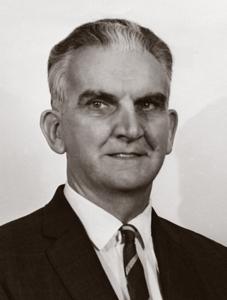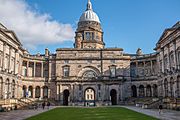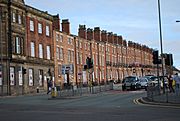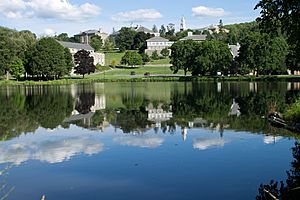Kenneth E. Boulding facts for kids
Quick facts for kids
K. E. Boulding
|
|
|---|---|
 |
|
| Born |
Kenneth Ewart Boulding
18 January 1910 |
| Died | 18 March 1993 (aged 83) |
| Nationality | English-born, American |
| Alma mater | Oxford University |
| Known for | Boulding's Hierarchy Kenneth Boulding's evolutionary perspective Spaceship Earth Loss of Strength Gradient |
| Spouse(s) | Elise M. Boulding (m. 1941; 5 children; William Boulding et al.) |
| Awards | John Bates Clark Medal (1949) 33 honorary degrees |
| Scientific career | |
| Fields | Economics Systems theory Evolutionary economics |
| Institutions | University of Edinburgh Colgate University Iowa State University University of Michigan The University of the West Indies University of Colorado at Boulder |
| Influences | Joseph Schumpeter Irving Fisher John Maynard Keynes |
Kenneth Ewart Boulding (born January 18, 1910 – died March 18, 1993) was an important thinker from England who later became an American citizen. He was an economist, a teacher, a peace activist, and a philosopher who studied many different subjects. Boulding wrote two very famous books: The Image: Knowledge in Life and Society (1956) and Conflict and Defense: A General Theory (1962). He helped start the idea of general systems theory, which looks at how different parts of a system work together. He also began many important projects in economics and social science. He was married to a sociologist named Elise M. Boulding.
Contents
Kenneth Boulding's Life Story
Growing Up and Early Studies
Kenneth Boulding was born and grew up in Liverpool, England. He was the only child of William C. Boulding and Elizabeth Ann Boulding. His father worked with gas pipes and was also a preacher in the Wesleyan Methodist Church. His mother was a housewife. Kenneth's middle name, Ewart, came from William Ewart Gladstone, a famous British prime minister whom his father admired. When Kenneth was a teenager, he became interested in pacifism, which means believing in peace and opposing war. He joined the Religious Society of Friends, a group known for its peaceful beliefs.
After going to Liverpool Collegiate School on a scholarship, Boulding won another scholarship to study chemistry at Oxford University in 1929. He soon changed his studies to Philosophy, Politics, and Economics. His economics teachers included Henry Phelps Brown and Maurice Allen. Boulding earned a top degree in economics in 1931. In his final year, he wrote an article that was published in The Economic Journal, after getting comments from its editor, John Maynard Keynes.

With a small university scholarship, Boulding spent another year at Oxford doing advanced studies. This led to a paper about how money moves between countries. In 1932, he won a Commonwealth Fellowship to study at the University of Chicago in the United States. On his way there, he met Joseph Schumpeter, another famous economist.
From 1932 to 1934, Boulding continued his economics studies at Chicago and at Harvard University. He took classes from important professors like Schumpeter, Henry Schultz, and Frank Knight. He also wrote some of his own articles. At Chicago, he became friends with another student named Albert Gailord Hart.
His studies were interrupted when he had a collapsed lung. After he recovered, he spent the last six months of his fellowship in Chicago, writing articles about how money and wealth are created. Two of these articles were published in The Quarterly Journal of Economics in 1934–1935. After returning to the UK for three years, Boulding settled in the U.S. and became an American citizen in 1948.
Teaching in Scotland

In the summer of 1934, Boulding returned to the UK and got a three-year job teaching economics at the University of Edinburgh. He felt that academic life there was not very exciting. He even made some people unhappy with a speech to students that was published in a newspaper with the headline, "Scottish University Sitting on Haunches for the last Fifty Years."
During this time, Boulding was very active in the Quaker community. He wrote a pamphlet about nonviolent methods in 1936. He also helped write a letter from the Quakers to the prime minister, asking Britain to remove the "war guilt" parts from the Treaty of Versailles and work towards a fairer peace.
He also learned about accounting theory, which helped him see a business as always trying to keep its financial records in balance. He explained that a company would react to changes in its money and goods. For example, if customers bought finished products, the company would have less inventory but more cash. This cash would then be used to buy materials and pay workers to make more products. This balance would always be changing as new technologies and products appeared.
In 1935, when he was 24, a famous economist named Frank H. Knight wrote an article about Boulding's work. This helped Boulding become known as an important thinker in social sciences.
A Career in American Universities
In the summer of 1937, Boulding returned to the US for a Quaker meeting in Philadelphia. He got a teaching job at Colgate University in New York. From 1937 to 1941, he taught economics there. He enjoyed his time at Colgate and felt comfortable with his colleagues. However, when Germany invaded Poland in September 1939 and his home country declared war, he felt very distressed and had strong feelings against the Germans. His Quaker beliefs in peace were shaken. But in May 1940, he had a special experience that brought back his faith in pacifism.
During this time of spiritual struggle, Boulding managed to finish his textbook, Economic Analysis. He had started this book during his summer breaks at Colgate. This book became very popular and earned him even more respect in economics.
From 1942 to 1943, Boulding taught at Fisk University, a school mainly for Black students in Nashville, Tennessee. From 1945 to 1949, he was a teacher at Iowa State College (now Iowa State University). From 1949 to 1967, he taught at the University of Michigan. In 1967, he joined the University of Colorado at Boulder, where he stayed until he retired.
Many important groups elected Boulding as their president. These included the American Economic Association in 1968–69, the Society for General Systems Research, and the American Association for the Advancement of Science (AAAS) in 1980. He was also president of the International Studies Association and the Peace Research Society. In 1978, Larry D. Singell said that Boulding was chosen for the AAAS because he made important contributions to science and could see science as a whole.
Boulding was nominated for the Nobel Prize several times, for both peace and economics. He was chosen as a member of the American Academy of Arts and Sciences (1957), the American Philosophical Society (1960), and the United States National Academy of Sciences (1975).
His Work for Peace
Boulding and his wife, Elise, were active members of the Religious Society of Friends, also known as Quakers. He attended Quaker meetings, served on committees, and spoke to and about the Friends. They were members of Quaker groups in Nashville, Ann Arbor, and Boulder. Even though he usually stuttered, when he spoke at a Friends meeting, he spoke very smoothly.
Kenneth Boulding helped organize the first Vietnam War teach-in at the University of Michigan in March 1965. A teach-in is a long meeting or protest where people discuss important issues. He later spoke at the university and was hit with snowballs by some students who disagreed with him.
In March 1977, he held a silent protest at the headquarters of the American Friends Service Committee in Philadelphia. He was protesting what he felt was the group moving away from Quaker principles. He also wrote a widely shared series of poems called "There is a Spirit" in 1945. These poems were based on the last words of a 17th-century Quaker named James Nayler.
Kenneth Boulding's Big Ideas
Boulding was known in universities for writing a lot and for connecting different areas of knowledge. He believed that economics and sociology were not separate social sciences. Instead, he saw them as parts of one big social science that studies people and how they relate to each other. Boulding was a leader in looking at economics in an "evolutionary" way, rather than just focusing on things staying balanced.
Boulding stressed that human behavior, including economic behavior, is part of a larger, connected system. To understand what happens because of our actions, we need to study and understand the "ecodynamics" of the whole global society we live in. This includes both its spiritual and material parts. Boulding thought that if we didn't try hard to do the right kind of social science research, humans might disappear. But he was hopeful, believing that our journey of evolution had just begun.
How Economies Change and Grow
Boulding was a strong supporter of the evolutionary economics movement. In his writings like "Economic Development as an Evolutionary System" (1961, 1964), Boulding suggested that economic development is similar to how living things evolve in biology. He believed that economies change and grow over time, just like species do.
The "Spaceship Earth" Idea
After Rachel Carson's book Silent Spring came out in 1962, people started paying more attention to how economic growth affects the environment. In his important 1966 essay, "The Economics of the Coming Spaceship Earth," Boulding pointed out that our economic system needs to fit with the Earth's natural system. He explained that Earth is like a spaceship with limited resources. This means we need to be careful with what we use and how we live, because our planet has a limited supply of everything.
See also
 In Spanish: Kenneth Boulding para niños
In Spanish: Kenneth Boulding para niños
- Holism in science
- Loss of Strength Gradient
- Spaceship Earth



